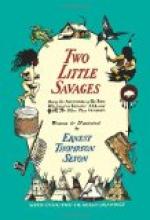When the ears were reached they were skinned and pulled out of the skull without cutting, then, after the eyes were passed, the skin and body looked as in Figure 2. Now the back of the head with the neck and body was cut off (Ct, Fig. 2), and the first operation of the skinning was done.
Yan got along fairly well, tearing and cutting the skin once or twice, but learning very quickly to manage it.
Now began the cleaning of the skin.
The eyes were cut clean out and the brains and flesh carefully scraped away from the skull.
The wing bones were already cleaned of meat down to the elbow joint, where the big quill feathers began, and the rest of the wing had to be cleared of flesh by cutting open the under side of the next joint (H to El, Fig. 1). The “pope’s nose” and the skin generally was freed from meat and grease by scraping with a knife and rubbing with the meal.
Then came the poisoning. Every part of the bones and flesh had to be painted with the creamy arsenical soap, then the head was worked back into its place and the skin turned right side out.
When this was done it was quite late. Guy was asleep, Sam was nearly so, and Yan was thoroughly tired out.
“Guess I’ll go now,” said Si. “Them skins is in good shape to keep, only don’t let them dry,” so they were wrapped up in a damp sack and put away in a tin till next night, when Si promised to return and finish the course in one more lesson.
[Illustration: Owl-stuffing plate]
OWL-STUFFING PLATE
Fig. 1. The dead Owl,
showing the cuts made in skinning it: A to
B, for the body; El to H,
on each wing, to remove the meat of the
second joint.
Fig. 2. After the skinning is done the skull remains attached to the skin, which is now inside out, the neck and body are cut off at Ct. Sn to Sn shows the slit in the nape needed for Owls and several other kinds.
Fig. 3. Top view of the
tow body, neck end up, and neck wire
projecting.
Fig. 4. Side view of
the tow body, with the neck wire put through
it; the tail end is downward.
Fig. 5. The heavy iron wire for neck.
Fig. 6. The Owl after
the body is put in; it is now ready to close
up, by stitching up the slit
on the nape, the body slit B to C and
the two wing slits El to H,
on each wing.
Fig. 7. A dummy as it would look if all the feathers were off; this shows the proper position for legs and wings on the body. At W is a glimpse of the leg wire entering the body at the middle of the side.
Fig. 8. Another view
of the body without feathers; the dotted
lines show the wires of the
legs through the hard body, and the
neck wire.
Fig. 9. Two views of
one of the wooden eyes; these are on a much
larger scale than the rest
of the figures in this plate.




